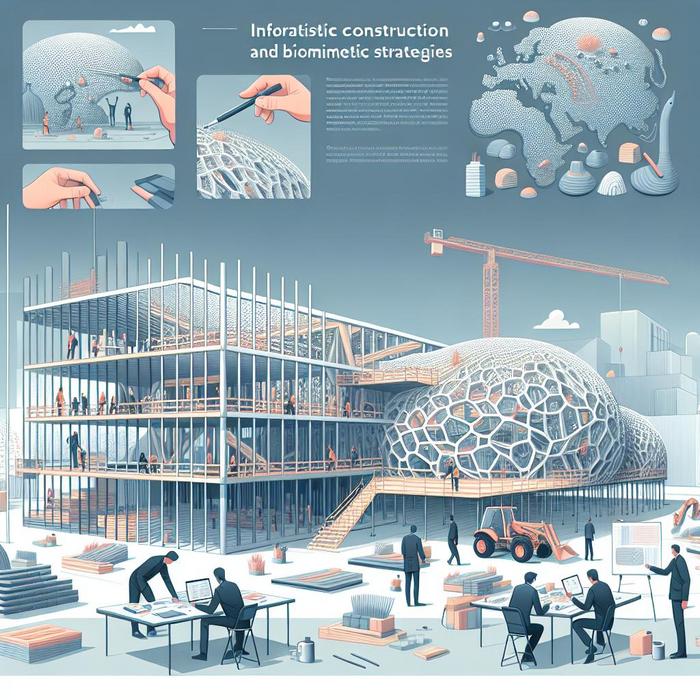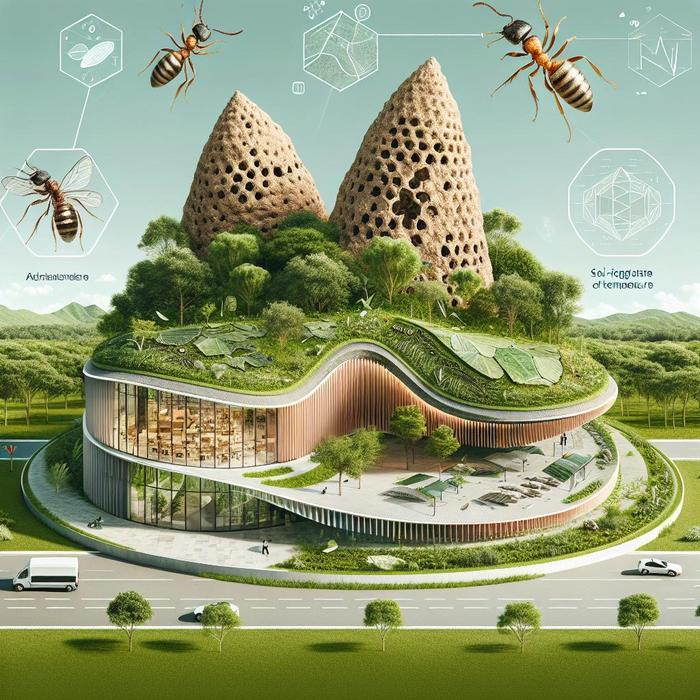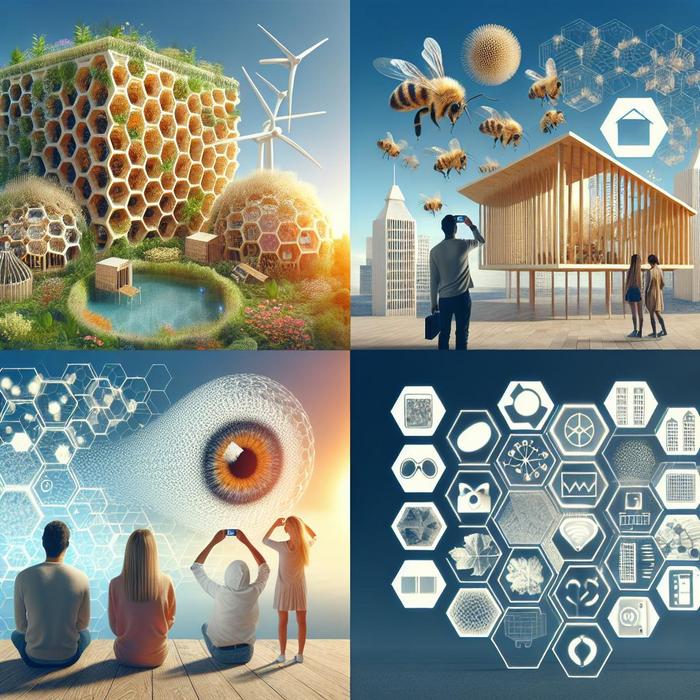Why not Learn from Nature’s Ingenious Strategies in Construction?
Could nature possibly hold the keys to revolutionizing construction practices? Have you ever contemplated how biomimicry, specifically biomimetic strategies, can transform the way we build, leading to more efficient, sustainable, and satisfying outcomes?
The Art of Learning from Nature
Consider how birds construct their nests, beavers build their dams, or termites engineer their mounds. By observing and learning from such natural phenomena, we can uncover ingenious approaches to design and construction. But how exactly does the practice of biomimeting fit into all this?
Unraveling the Essence of Biomimicry
Derived from the Greek words for life and imitation, biomimicry is all about emulating nature’s tactics to solve human problems. It not only involves mimicking forms and processes, but also aims to understand the principles that underlie them. This approach aims to tap into the 3.8 billion years of ‘R&D’ that nature has already invested in.
The Advent of Biomimetic Strategies in Construction
Applying biomimetic strategies to construction is not a new concept. From the architectural grandeur of the Gaudi’s Sagrada Familia, inspired by tree canopies, to the Eastgate Centre in Zimbabwe, modelled after termite mounds for natural cooling, biomimetic principles have been employed to create sustainable and efficient structures. So, why does this matter, and how can it propel us towards greater construction satisfaction?
Framing Biomimicry’s Role in Pioneering Sustainable Construction
By embracing the principles of biomimicry, we can make construction more sustainable, resilient, and efficient. Imagine buildings that clean the air, surfaces that don’t need cleaning, or structures that can self-repair – innovations inspired by nature’s genius.
A Marriage of Biology and Architecture
Biologists identify effective and sustainable processes in nature, and engineers translate these designs into building or tool designs. Reflecting this synergy, biomimicry engineering – the art of creating designs based on nature’s structures and sequences – has emerged as a powerful tool in sustainable infrastructure development. More than that, this approach has the potential to revolutionise how we approach everyday activities and processes, like public transportation or water sanitation.
Forecasting the Future: Biomimicry in Construction
So, what does the future look like with the application of biomimetic strategies in construction? The possibilities are vast and inspiring, as are the anticipated benefits. With projects like the Living Building at Georgia Tech leading the way, the future of construction seems to be focused on learning from nature and integrating its tactics into our building practices.
Innovation Inspired by Nature
Nature does not waste. In the natural world, waste from one organism typically becomes food for another. Imagine if our buildings did the same, if waste streams were minimised or reused effectively, wouldn’t that transform our urban landscapes? But it doesn’t stop there. From disaster-resilient housing inspired by palm trees to super-efficient ventilation systems modeled on termite mounds, the potential for biomimicry-inspired innovation in construction is vast.
Satisfying Building Users and Protecting the Planet
By harnessing nature’s tactics, we can derive satisfaction not only from the end product but also from the process of creating it. A building that not only aesthetically pleases but also performs efficiently, mimics natural systems, and contributes positively to its surrounding ecosystem – isn’t that a construction dream come true?
Are We Ready to Embrace Biomimicry Fully?
Indeed, we are living in exciting times, with the potential for groundbreaking transformations in how we approach construction. But are we ready to fully embrace the biomimetic strategies championed by biomimetics engineers and other professionals? Do we have the courage to learn from nature’s tried and tested tactics to pave the way for a more sustainable and satisfying future? Only time can tell. But one thing is clear – the potential is immense, and the journey is only just beginning.
Can Biomimicry Shape the Future of Our Cities?
Ever wondered how a city designed with inspiration from nature would look? What miracles could be unveiled if the principles of biomimicry were applied to urban planning? Could our urban spaces transform into sustainable, resilient systems, if guided by nature’s lessons?
The Synergy Between Urban Ecosystems and Natural Processes
Our rapid urbanization has often paralleled a disconnect with the natural world. One might argue, however, that at the core of making our modern habitats sustainable and resilient lies an intimate understanding and incorporation of natural processes. What if our cities functioned like ecosystems, where resources are reused, waste is minimized, and systems are adaptable?
Harnessing the Power of Biomimetic Urban Planning
Biomimetic urban planning represents a phenomenal shift towards building sustainable and resilient urban habitats. The insights drawn from 3.8 billion years of nature’s ‘R&D’, when woven into our urbanization efforts, can lead to cities that not just conserve resources but also thrive on resilience. With continued emphasis on smart and green cities, is this the appropriate moment to appreciate and apply the wisdom nature offers?
Biomimicry in Cityscapes: What Could It Mean?
Envision self-healing buildings that absorb pollutants, roads that mimic photosynthesis to reduce heat effects, or urban water management systems inspired by the dynamic water management strategies of plants. By imitating nature’s methods, we can introduce innovations that brilliantly tackle urbanization challenges. Can we truly imagine cities where optimal use of resources, energy efficiency, and resilience are not just mandated, but the reality?
Real-Life Examples: Reflecting Nature’s wisdom in City architectures
The biomimicry approach in city planning and architecture is not a suggestion of futuristic, idealistic hopes, but indeed, a reality in many parts of the world. Can our cities take a leaf from groundbreaking projects like Singapore’s Parkroyal on Pickering Hotel that displays an intense integration of greenery, or the Bullitt Center in Seattle, known as the world’s most energy-efficient commercial building inspired by the native Douglas Fir forests?
Nature-inspired Innovation: A Key to Urban Sustainability
The wisdom of nature, when translated into biomimetic designs, brings forth amazing innovations. For instance, consider Velcro, a widely used fastening system, inspired by burdock burrs noticed by Swiss electrical engineer George de Mestral. By biomimeting the micro-features of adhesive processes discovered in nature, he created a novel solution to a universal challenge. Can such nature-inspired innovations be the key to promoting sustainable urban ecosystems?
Collaboration Across Disciplines: The Driving Force
Perhaps the beauty of biomimicry lies in the synergy it requires across disciplines. Professionals from diverse fields like biology, engineering, architecture, and environmental science need to collaborate to translate nature’s wisdom into concrete urban plans successfully. Are we ready to break the traditional silos and foster this cross-disciplinary collaboration?
Inspired by Nature: Changing the Face of Urban Systems
From waste management to transportation design, energy efficiency to building architecture, every aspect of urban planning has the potential to benefit from biomimicry. However, manifesting this would necessitate a fundamental shift in our perception, our design principles. It calls for seeing our cities not as concrete jungles, but as interwoven ecosystems, where every element has systemic linkages and implications, much like the workings of a natural ecosystem. Are we ready to witness this radical makeover?
High Stakes: The Imperative of Sustainable Urbanization
There is no doubt about the magnitude of the challenges ahead in terms of urbanization. With more than half of the world’s population living in urban areas, a figure projected to rise further, the stakes have never been higher. Can we afford to ignore the guiding principles nature provides us, ones that have withstood millions of years of evolution?
Our Future Cities: Not Just Surviving, But Thriving
The testament of successful urbanization lies not just in surviving, but thriving. It calls for sustainability built against the backdrop of resilience and adaptability. It demands us to aim beyond just ‘green’, to envision designed systems that can cope, recover, and adapt, just like a natural ecosystem. Is it time to heed nature’s strategies to design our future cities?
Transforming Our Cities: A Vision Rooted in Biomimicry
The choices we make now will shape the future of our urban habitats. With biomimicry’s transformative tools, we have an opportunity to develop cities that are not just livable but thrive on the principles of natural ecosystems. Will we rise to the occasion and take up nature’s available mantle of wisdom to build our urban landscapes? The future of our cities lies indubitably in the answers to these questions.
The Time to Act is Now
The notion of looking towards nature for solutions is not novel. It’s a proposal initiated by individuals like biomimetics researchers or experts in biomimicry engineering who have spent years studying and propagating the immense potential nature holds for our survival and progress. However, the time to break free from this perception as an interesting approach to an essential part of our urban planning process is long overdue. In this era of increasing urbanization, can we afford to delay the integration of biomimicry principles into our urban systems?
Embracing a Biomimetic Future
Our current pace of urban development and resource consumption necessitates a shift towards more sustainable practices. As we strive to meet the demands of flourishing urban populations, maybe the solution lies in looking back at nature. If we can cultivate an understanding of natural systems and weave that wisdom into our innovative solutions, perhaps we can redefine the way we develop our cities, leading to truly sustainable urban landscapes that do more than just exist—they thrive. Biomimicry provides our urban future a ray of hope, mirrored through nature. The question is, Are we ready to seize it?
Moving Towards a Biomimicked Urban Future
While we have started taking strides towards adopting biomimicry in small scales, the real challenge lies in its comprehensive implementation. The benefits derived would be immense—a resilient urban ecosystem that minimizes its carbon footprint, effectively manages waste, utilizes renewable resources, and incorporates energy-efficient mechanisms. It is a future where our cities emulate natural ecosystems, not just superficially, but by incorporating their systemic efficiency. The inevitability of moving towards such a future is made even more imperative if we are to survive and thrive as a species.
Fulfilling the Promise of Sustainable Urbanization: The Biomimicry Way
With the burgeoning global urban population and the pressing need to curb carbon emissions, the path to sustainable urbanization lies in scaling up biomimicry principles. It requires a bottom-up approach, an overhaul of conventional methods, and a willingness to take inspiration from nature’s millions of years of research. Can we fulfil the promise of sustainable urbanization through biomimicry? The potential is immense, but the critical first step in this direction is ours to take.
Stepping into an Era of Biomimicry Inspired Urban Development
Embracing biomimicry is more than an option; it could be a defining strategy in shaping the future growth and development of our urban landscapes. The call to action is clear – to see our cities through the lens of nature, to learn from its innate wisdom, and to reflect this wisdom in the course of our urban development. It’s about viewing cities as organisms, as living, breathing entities that grow, evolve and adapt. How we respond to this call will inevitably shape our shared urban future.
Shaping a New Definition of Progress: A Biomimicry Inspired Urbanscape
Modern cities are symbols of progress, centers of innovation, and economic growth. In the haste of such rapid development, we often forget the intricate connect that exists between our cities and natural ecosystems. As we strive to find solutions for creating sustainable cities, can biomimicry pave the way for ushering a new era of urban development? A development where progress is no longer detrimental to our planet, but in harmony with its natural systems.
Overcoming Urbanization Challenges: The Biomimicry Approach
The rapid proliferation of urban areas has not only strained natural resources but also posed daunting challenges to ensuring sustainable living conditions. But, what if our approach to tackling these challenges was to turn to nature and its time-tested solutions? With the promise of biomimicry, comes the prospect of overcoming daunting urbanization challenges while ensuring a sustainable future. Can adopting the principles of biomimicry be our key to unlocking sustainable urban development?
Setting the Agenda for Future Cities: Biomimicry at the Core
The steadily growing interest in biomimicry has demonstrated its potential in guiding sustainable solutions at every level – ranging from product design to city planning. As we navigate the complexities of urban growth, incorporating the principles of biomimicry in our urban planning agenda can help us design cities that resonate with the underlying principles of natural ecosystems. Are we ready to set the groundwork for cities that are not just sustainable, but resilient, livable, and in harmony with nature?


